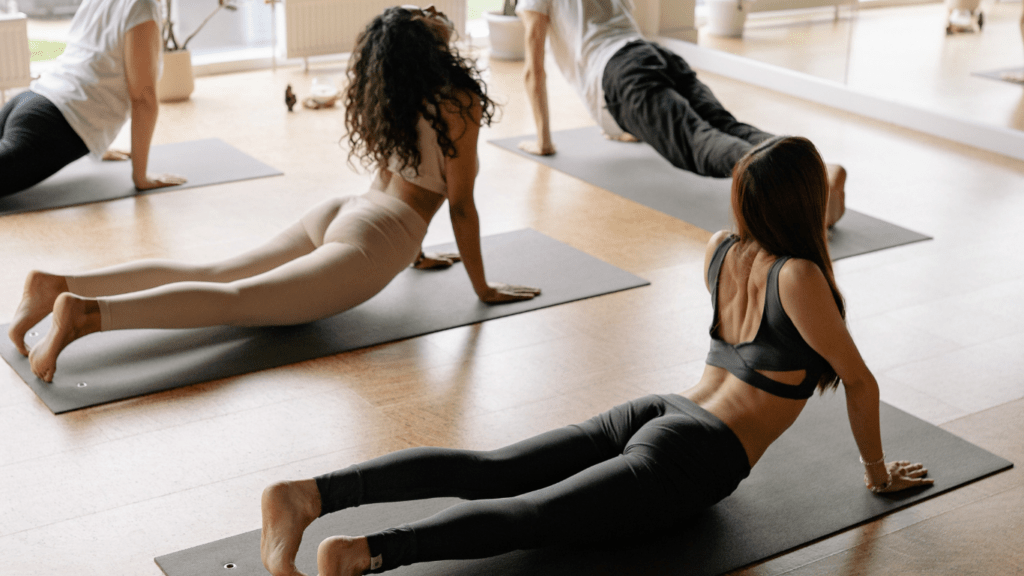Understanding Hot Yoga
Hot yoga takes place in a room heated to around 90-105 degrees Fahrenheit. This controlled environment mimics the climate of India, where traditional yoga began. Practicing in such conditions helps enhance the physical and mental benefits of yoga.
Hot yoga involves various styles. Bikram yoga, perhaps the most well-known, follows a sequence of 26 postures. Other styles include:
- Hot Vinyasa
- Hot Power Yoga
Each style offers a unique approach but aims to improve strength, flexibility, and endurance.
Performing yoga in elevated temperatures improves flexibility. The heat allows muscles to stretch more effectively, reducing the risk of injury. For example, deeper poses become manageable during sessions.
Detoxification is another key benefit. Sweating profusely during a session helps expel toxins from the body. This cleansing effect can lead to clearer skin and improved overall health.
Mental clarity also improves due to hot yoga. Practitioners often report a sense of mental stillness and concentration. This heightened focus contributes to reduced stress and increased mindfulness throughout the day.
Hydration is crucial when engaging in hot yoga. The intense heat and excessive sweating require consistent water intake before, during, and after sessions. This practice prevents dehydration and maintains energy levels.
Wearing the right attire enhances the experience. Lightweight, breathable fabrics suit hot yoga best. Tight-fitting clothes prevent discomfort and distractions while moving through poses.
Adapting to hot yoga may take time. Beginners should start slowly, attending a few classes a week at their own pace. Gradual acclimatization aids in harnessing the full benefits without overexertion.
Understanding these aspects of hot yoga can help optimize the experience. Whether improving flexibility, achieving mental clarity, or detoxifying the body, hot yoga offers comprehensive benefits worth exploring.
Physical Benefits of Hot Yoga

Hot yoga offers numerous physical benefits due to practicing in a heated environment. These benefits include enhanced flexibility and strength, cardiovascular improvement, and detoxification.
Enhanced Flexibility and Strength
Practicing hot yoga significantly enhances flexibility and strength. The heat warms up muscles, allowing for deeper stretches and reduced risk of injury. It also pushes the body to build strength as poses are held for longer durations. For example, deeper lunges and extended holds in poses like Warrior II build leg and core strength effectively.
Cardiovascular Improvement
Hot yoga sessions markedly improve cardiovascular health. The elevated room temperature increases heart rate, providing a workout similar to aerobic exercises. By enhancing blood flow and oxygen delivery throughout the body, this practice aids in better cardiovascular function. For instance, sequences like Sun Salutations boost heart rate consistently.
Detoxification
Practicing hot yoga aids in detoxification through sweating. The intense heat stimulates sweat glands, helping to expel toxins and impurities from the body. This process supports the body’s natural detoxification system and promotes clearer skin. After a rigorous session, one often feels rejuvenated and cleansed due to the excessive sweating involved.
Mental Health Benefits
Hot yoga isn’t just about physical strength and flexibility. It offers significant benefits for mental well-being, too.
Stress Reduction
Hot yoga reduces stress levels significantly. The combination of heat and physical exertion promotes the release of endorphins, improving mood post-session. Controlled breathing techniques used during poses also encourage a calm and centered mind, making it easier to manage daily stressors. Studies indicate that regular practice lowers cortisol levels, aiding in overall stress reduction.
Improved Focus and Mindfulness
Regular hot yoga enhances focus and mindfulness. The demanding environment requires practitioners to concentrate on their breath and movements, fostering a heightened sense of presence. This practice trains the mind to stay in the moment, improving cognitive abilities and decreasing mental distractions. Many participants report a lasting sense of clarity and mental sharpness after each session, showing the immediate benefits of improved focus.
Potential Risks and Precautions
Hot yoga offers various benefits, but it’s essential to understand the potential risks and take necessary precautions. Awareness of these aspects ensures a safe and enjoyable practice.
Hydration and Heat-Related Issues
Maintaining hydration is crucial during hot yoga. The elevated temperatures lead to increased sweating, which can result in rapid fluid loss. Consuming water before, during, and after class keeps the body hydrated. Electrolyte-rich drinks can also help replace vital minerals lost through sweat. Overheating can cause dizziness, nausea, or heat exhaustion, so listening to your body and taking breaks if needed is essential.
Proper Gear and Attire
Wearing appropriate gear enhances comfort and safety in hot yoga. Lightweight, moisture-wicking fabrics help manage sweat and keep the body cool. Tight-fitting clothing is advisable to prevent discomfort and unnecessary distractions.
Mats designed for hot yoga provide better grip and reduce the risk of slipping. Towels can assist in managing sweat during intense sessions. Using the right gear minimizes distractions and maximizes the benefits of hot yoga.
Tips for Getting Started with Hot Yoga
Newcomers to hot yoga can find it intimidating. Following these tips helps ease into the practice and maximize benefits.
Choosing the Right Class
Research different styles of hot yoga. Bikram, with its set sequence of 26 poses, differs from Vinyasa, which includes flow sequences. Check local studio schedules and read class descriptions to find one matching your fitness level and interests. For beginners, a lower-temperature class, like warm yoga, might be more accessible.
Preparing for Your First Session
Stay hydrated throughout the day. Drinking water before, during, and after the session is crucial to preventing dehydration. Wear light, moisture-wicking clothing.
These fabrics help keep sweat off your skin, improving comfort. Bring a towel and a mat designed for gripping under sweaty conditions. Avoid heavy meals at least two hours before class to prevent discomfort during poses.
Post-Session Recovery
- Rehydrate immediately after class. Electrolyte-infused drinks recover lost minerals efficiently.
- Stretch gently to help muscles cool down and reduce soreness.
- Take a cool shower to help lower body temperature and invigorate the skin.
- Rest and listen to your body; if you feel excessively fatigued, consider shorter or less intense classes next time.
Following these tips ensures a safe and rewarding hot yoga experience, paving the way for long-term practice and benefits.
 Laurae Parhamim is the founder of Top Wellness Activity Hub, a comprehensive platform dedicated to promoting holistic health and wellness. With a passion for well-being and a deep understanding of the latest trends in health practices, Laurae has crafted a space that serves as a go-to resource for individuals seeking to enhance their physical, mental, and emotional health. Under Laurae's leadership, the platform offers a wide array of content, from nutritious eating tips to the intricacies of yoga, Pilates, and meditation. The goal is to provide valuable insights and practical advice that empower individuals to lead healthier, more balanced lives.
Laurae's dedication to wellness stems from a belief in the transformative power of healthy habits and mindful practices. Recognizing the importance of accessible, reliable information, Laurae has also integrated gear reviews and updates on wellness trends to ensure users are well-equipped on their journey to well-being. This comprehensive approach reflects Laurae's commitment to creating a platform that caters to both beginners and seasoned wellness enthusiasts. As the visionary behind Top Wellness Activity Hub, Laurae continues to innovate, inspire, and guide others towards achieving their wellness goals.
Laurae Parhamim is the founder of Top Wellness Activity Hub, a comprehensive platform dedicated to promoting holistic health and wellness. With a passion for well-being and a deep understanding of the latest trends in health practices, Laurae has crafted a space that serves as a go-to resource for individuals seeking to enhance their physical, mental, and emotional health. Under Laurae's leadership, the platform offers a wide array of content, from nutritious eating tips to the intricacies of yoga, Pilates, and meditation. The goal is to provide valuable insights and practical advice that empower individuals to lead healthier, more balanced lives.
Laurae's dedication to wellness stems from a belief in the transformative power of healthy habits and mindful practices. Recognizing the importance of accessible, reliable information, Laurae has also integrated gear reviews and updates on wellness trends to ensure users are well-equipped on their journey to well-being. This comprehensive approach reflects Laurae's commitment to creating a platform that caters to both beginners and seasoned wellness enthusiasts. As the visionary behind Top Wellness Activity Hub, Laurae continues to innovate, inspire, and guide others towards achieving their wellness goals.